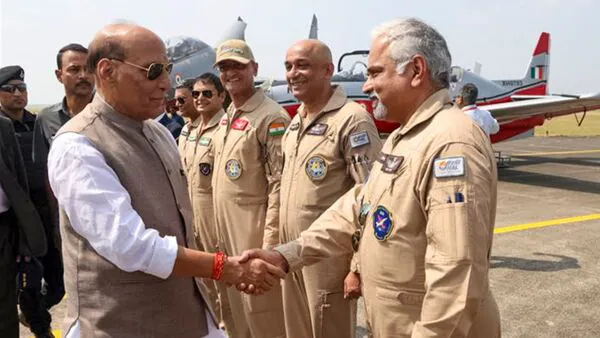
Rajnath Singh Hails HAL's Round-The-Clock 'Maintenance' Backing To IAF During Operation Sindoor
His remarks came during the inauguration of two new manufacturing units at HAL's production hub in Nashik, one dedicated to the Tejas Light Combat Aircraft (LCA) Mk1A and another for the HTT-40 trainer aircraft.
“In our security history, there have been only a few instances when the entire system has truly been tested simultaneously. Operation Sindoor was one such mission,” Singh said.
“The HAL provided support at various operational sites 24 hours a day during the operation. It ensured the Indian Air Force 's operational readiness by carrying out prompt maintenance on fighter jets and helicopters,” he said.
Also Read | Operation Sindoor: Over 100 Pakistan soldiers killed, says DGMO Lt Gen GhaiIn his remarks, the defence minister also noted the HAL's integration of BrahMos missiles into Sukhoi-30 MKI jets and said the weapons destroyed many terrorist hideouts during Operation Sindoor.
While underlining the importance of self-reliance in defence to meet future security challenges, Singh said India is looking at taking domestic defence production to 100 per cent as dependence on foreign military supplies creates "strategic vulnerability.
"Now India is doing 65 per cent manufacturing on its own soil. Very soon, we will take our domestic manufacturing to 100 per cent as well," he said.
The new production facility for Tejas MK1A will help HAL produce at least 24 LCAs annually.
HAL's Chairman and Managing Director DK Sunil termed the successful operationalisation of the LCA Mk1A and HTT-40 production from Nashik as a testament to the aerospace major's capacity for expansion.
"The HAL's Nashik division's capacity to produce indigenous advanced fighters in addition to Sukhoi-30MKI has added momentum to our production efforts to meet delivery timelines."
The defence minister said the HAL's Nashik team performed the "crucial task" of installing the BrahMos missile on the Sukhoi-30 MKI jets, which destroyed terrorist hideouts during the operation.
“This proved that when it comes to national security, we can make our own equipment and protect ourselves with it,” he said.
Singh also witnessed a maiden flight by a Tejas LCA Mk1A manufactured at the Nashik facility.
In his address, Singh described the flight of the aircraft as a shining symbol of India's growing self-reliance in defence.
Highlighting the transformation of the defence sector in the last decade, he asserted that India which once imported 65-70 per cent of critical military hardware, is now manufacturing 65 per cent of the equipment on its own soil.
The defence minister also lauded HAL's Nashik facility for playing a pivotal role in taking India's defence manufacturing capabilities to "newer heights" for over six decades.
From manufacturing and overhauling fighter jets such as MiG-21 and MiG-27 to becoming the production hub of Sukhoi-30MKIs, this campus has become a glowing symbol of India's self-reliance in the defence sector, he said.
Singh also pointed out that the ongoing construction of the LCA Tejas and HTT-40 aircraft is also the result of collaboration between various industry partners of the country.
"This collaboration is proof that if the government, industries, and academia work together, no challenge is too big," he said, acknowledging the trust placed by the Indian Air Force in aircraft such as Tejas and HTT-40.
"When we came to power in 2014, we realised that without self-reliance, we can never be truly secure. In the beginning, we faced numerous challenges, the biggest being 'limited defence preparedness' and 'import dependency'," he said.
"Everything was limited to government enterprises, and the private sector had no significant participation in the production ecosystem. In addition, there was not enough focus on defence planning, advanced technology, and innovation," he said.
Also Read | IAF chief BIG reveal: India downed 5 Pakistani fighter jets in Op SindoorSingh said this forced the government to depend on other countries for critical equipment and cutting-edge systems, which increased costs and created strategic vulnerabilities.
“This challenge encouraged us to move forward in the direction of new thinking and reforms. The results are visible today. We not only reduced import dependency, but also strengthened our commitment to indigenisation,” he said.
This proved that when it comes to national security, we can make our own equipment and protect ourselves with it."Whatever we used to buy from abroad, we are now manufacturing it domestically, be it fighter aircraft, missiles, engines and electronic warfare systems," Singh said.
(With inputs from PTI)
Legal Disclaimer:
MENAFN provides the
information “as is” without warranty of any kind. We do not accept
any responsibility or liability for the accuracy, content, images,
videos, licenses, completeness, legality, or reliability of the information
contained in this article. If you have any complaints or copyright
issues related to this article, kindly contact the provider above.
Most popular stories
Market Research
- Thinkmarkets Adds Synthetic Indices To Its Product Offering
- Ethereum Startup Agoralend Opens Fresh Fundraise After Oversubscribed $300,000 Round.
- KOR Closes Series B Funding To Accelerate Global Growth
- Wise Wolves Corporation Launches Unified Brand To Power The Next Era Of Cross-Border Finance
- Lombard And Story Partner To Revolutionize Creator Economy Via Bitcoin-Backed Infrastructure
- FBS AI Assistant Helps Traders Skip Market Noise And Focus On Strategy




















Comments
No comment